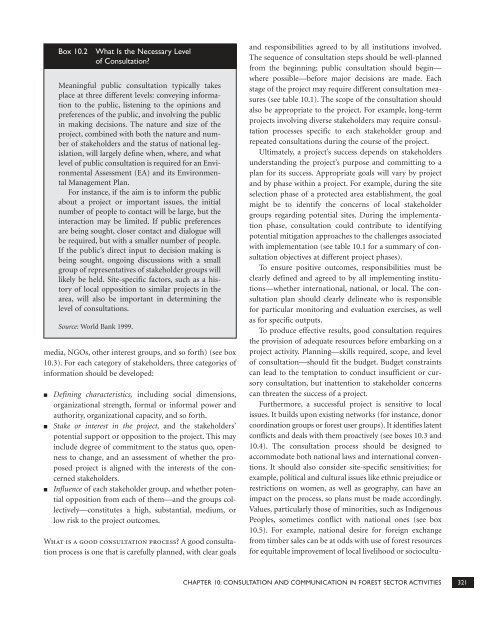Forests Sourcebook - HCV Resource Network
Forests Sourcebook - HCV Resource Network
Forests Sourcebook - HCV Resource Network
Create successful ePaper yourself
Turn your PDF publications into a flip-book with our unique Google optimized e-Paper software.
media, NGOs, other interest groups, and so forth) (see box<br />
10.3). For each category of stakeholders, three categories of<br />
information should be developed:<br />
■<br />
■<br />
■<br />
Box 10.2<br />
What Is the Necessary Level<br />
of Consultation?<br />
Meaningful public consultation typically takes<br />
place at three different levels: conveying information<br />
to the public, listening to the opinions and<br />
preferences of the public, and involving the public<br />
in making decisions. The nature and size of the<br />
project, combined with both the nature and number<br />
of stakeholders and the status of national legislation,<br />
will largely define when, where, and what<br />
level of public consultation is required for an Environmental<br />
Assessment (EA) and its Environmental<br />
Management Plan.<br />
For instance, if the aim is to inform the public<br />
about a project or important issues, the initial<br />
number of people to contact will be large, but the<br />
interaction may be limited. If public preferences<br />
are being sought, closer contact and dialogue will<br />
be required, but with a smaller number of people.<br />
If the public’s direct input to decision making is<br />
being sought, ongoing discussions with a small<br />
group of representatives of stakeholder groups will<br />
likely be held. Site-specific factors, such as a history<br />
of local opposition to similar projects in the<br />
area, will also be important in determining the<br />
level of consultations.<br />
Source: World Bank 1999.<br />
Defining characteristics, including social dimensions,<br />
organizational strength, formal or informal power and<br />
authority, organizational capacity, and so forth.<br />
Stake or interest in the project, and the stakeholders’<br />
potential support or opposition to the project. This may<br />
include degree of commitment to the status quo, openness<br />
to change, and an assessment of whether the proposed<br />
project is aligned with the interests of the concerned<br />
stakeholders.<br />
Influence of each stakeholder group, and whether potential<br />
opposition from each of them—and the groups collectively—constitutes<br />
a high, substantial, medium, or<br />
low risk to the project outcomes.<br />
What is a good consultation process? A good consultation<br />
process is one that is carefully planned, with clear goals<br />
and responsibilities agreed to by all institutions involved.<br />
The sequence of consultation steps should be well-planned<br />
from the beginning; public consultation should begin—<br />
where possible—before major decisions are made. Each<br />
stage of the project may require different consultation measures<br />
(see table 10.1). The scope of the consultation should<br />
also be appropriate to the project. For example, long-term<br />
projects involving diverse stakeholders may require consultation<br />
processes specific to each stakeholder group and<br />
repeated consultations during the course of the project.<br />
Ultimately, a project’s success depends on stakeholders<br />
understanding the project’s purpose and committing to a<br />
plan for its success. Appropriate goals will vary by project<br />
and by phase within a project. For example, during the site<br />
selection phase of a protected area establishment, the goal<br />
might be to identify the concerns of local stakeholder<br />
groups regarding potential sites. During the implementation<br />
phase, consultation could contribute to identifying<br />
potential mitigation approaches to the challenges associated<br />
with implementation (see table 10.1 for a summary of consultation<br />
objectives at different project phases).<br />
To ensure positive outcomes, responsibilities must be<br />
clearly defined and agreed to by all implementing institutions—whether<br />
international, national, or local. The consultation<br />
plan should clearly delineate who is responsible<br />
for particular monitoring and evaluation exercises, as well<br />
as for specific outputs.<br />
To produce effective results, good consultation requires<br />
the provision of adequate resources before embarking on a<br />
project activity. Planning—skills required, scope, and level<br />
of consultation—should fit the budget. Budget constraints<br />
can lead to the temptation to conduct insufficient or cursory<br />
consultation, but inattention to stakeholder concerns<br />
can threaten the success of a project.<br />
Furthermore, a successful project is sensitive to local<br />
issues. It builds upon existing networks (for instance, donor<br />
coordination groups or forest user groups). It identifies latent<br />
conflicts and deals with them proactively (see boxes 10.3 and<br />
10.4). The consultation process should be designed to<br />
accommodate both national laws and international conventions.<br />
It should also consider site-specific sensitivities; for<br />
example, political and cultural issues like ethnic prejudice or<br />
restrictions on women, as well as geography, can have an<br />
impact on the process, so plans must be made accordingly.<br />
Values, particularly those of minorities, such as Indigenous<br />
Peoples, sometimes conflict with national ones (see box<br />
10.5). For example, national desire for foreign exchange<br />
from timber sales can be at odds with use of forest resources<br />
for equitable improvement of local livelihood or sociocultu-<br />
CHAPTER 10: CONSULTATION AND COMMUNICATION IN FOREST SECTOR ACTIVITIES 321

















